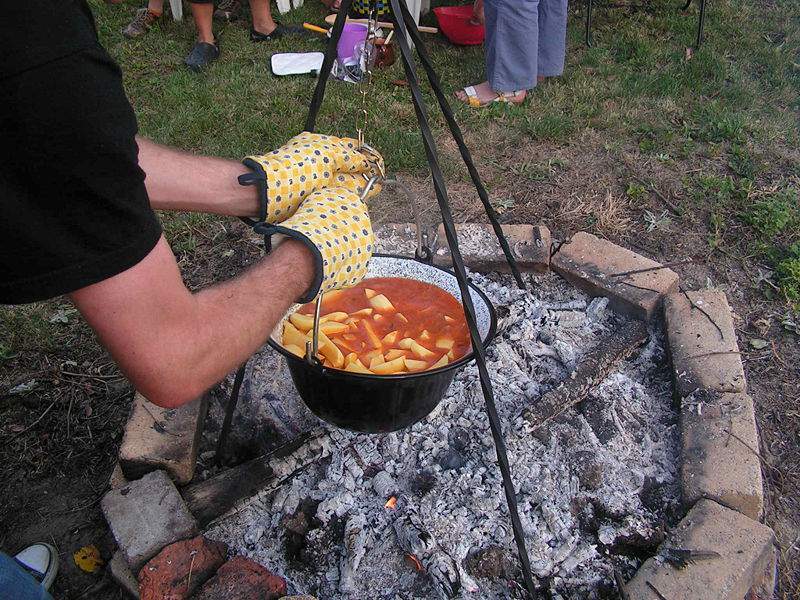3 Hungarian recipes for the traditional outdoor cooking, ‘bográcsozás’

Continuing with our quarantine recipes, you can now try out three more. This week, we cover the traditional method of ‘bográcsozás’, meaning to cook outside in a pot over fire. Of course, you could probably get away with preparing them inside, but going to your garden and spending some quality time with your close family is something that is important and makes the food taste even better. As the weather gets better and spring is coming, if you have a garden or a private area, get the best out of the quarantine and try out these delicious Hungarian recipes. I am certain you will not regret it.
Some tips from Magyarorszagom:
You should cover your freshly bought kettle or ‘Hungarian pot’ with lard or oil and bake the coating on heavy fire. Clean the pot afterwards with fine sand, then simply rinse it. You can repeat this process after cooking to get rid of tough, dried food residue as well.
It is best to cook over fire, not ember, as it is important for the pot to get heat evenly. You should put rocks or bricks around the fireplace to better control the fire and direct it towards the pot. Always make sure that it is safe to make a fire.
Feel free to cut down on the portions as they tend to be for four or more people, but take into consideration that it is easier to cook large amounts over the fire in a kettle or ‘Hungarian pot’ (bogrács).
Read our other articles on ‘bográcsozás’ to get to know about the history and to get even more tips about this Hungarian tradition:

Paprikás krumpli (Hungarian Potato Paprikash)
This is one of those easy Hungarian dishes that anyone should try to make as it is very rewarding. Do not underestimate its simplicity, though, as it is very delicious, and it is even better if prepared outdoors over the fire in a kettle or ‘Hungarian pot’ (bogrács). It can be prepared fast, and it is a very filling dish. It is certain that one cooking will be enough for the whole weekend.
Ingredients:
2 kg potatoes
3 onions
mangalitza or pork fat (lard)
20 dkg smoked bacon
1 stick hard-cured sausage
3 tablespoons of paprika
salt and pepper
Directions:
Dice the onions, the smoked bacon, and the potatoes, and slice the sausage as well. Start by adding the lard and the onions. You should cook them until they get glossy or slightly yellowish, but not brown. Add in the bacon and sear it, but be careful not to burn the onions. You can add in the sausage slices and cook it with the other ingredients for a little bit. Remove the pot from the fire, add in the paprika, and stir it. It is important to remove the pot from the fire because if you burn paprika, it becomes bitter. Add the potatoes and stir well. Put the pot back on the fire and add as much water that it covers the potatoes. You can now add salt and pepper to your liking and cook it until it thickens.

Goulash
The traditional Hungarian goulash is best in a ’Hungarian pot’ or kettle (bogrács). You can adjust this base recipe however you like. Some people add diced green pepper, tomatoes, or more vegetables like turnip. Feel free to experiment and come up with your own family recipe. The most important thing is quality meat, which you should not skimp on, nor on the vegetables that help give it more flavour. You can omit the noodles entirely, especially if you are making it as a soup, but you can also make it thicker if you prefer it that way. In my opinion, it is best with some fresh bread to soak up the broth with or to clean those last bits from your plate.
Ingredients:
1 kg beef (shank or crop)
2-3 big onions
50 dkg of potatoes
3 carrots
2 parsley roots
1 head garlic
2 tablespoons of paprika
2 teaspoons of ground caraway seed
mangalitza or pork fat (lard)
parsley
salt and pepper
for the noodles:
1 large egg
10-12 dkg of flour
salt
Directions:
First, you need to prepare the ingredients and light the fire. Wash and peel the vegetables. Cut the meat into bite-sized cubes. Dice the onions, slice the carrots, parsley roots, and the potatoes if they are too big. You can cut them into smaller pieces, but I usually prefer the potato pieces to be bigger than the meat.
Start by adding the lard and onions into the pot. You should cook them until they get glossy or slightly yellowish, but not brown. You can add in the garlic as well, stir it and remove the pot from the fire. Add in the meat cubes, the ground caraway seed, and the paprika powder, and mix it well together. It is important to remove the pot from the fire because if you burn paprika, it becomes bitter. After mixing it together, you can put it back over the fire and add just a little water if needed. After the water is cooked away, you can season it with salt and pepper. Now you can add in the potatoes, carrots, and parsley roots. It is usually at this step that some people add diced green pepper or tomatoes. You need to add water to cover everything. Now you must be patient as the meat and potatoes can take about 2 hours to cook well. If you want a soup, add some water to the pot as it cooks away. Meanwhile, you can prepare the noodles: simply mix the eggs, the flour, and some salt together. If everything in the goulash has softened, add in the noodles by tearing bite-sized pieces. You need to cook it for 10 more minutes, and then the meal is ready. Enjoy with a little parsley on top.

Pörkölt (Hungarian Stew)
You can prepare almost any type of stew in a kettle or ‘Hungarian pot’ (bogrács), but this might be the most characteristic Hungarian stew. However, it is important to note that – just like many recipes in Hungary – almost every family makes it their own way, so have a go at it and create your own traditional recipe. You can make it with pork or chicken as well; the recipe is more or less the same, it only affects cooking time. If you cook it in a pot – why not, it is even more delicious that way –, I would recommend beef or pork because you cannot control the heat of the fire as much. So let’s see the beef stew recipe.
Ingredients:
3 kg beef shank
4-5 large onions
4-5 cloves of garlic
3 dl dry red wine
mangalitza or pork fat (lard)
2 tablespoons of paprika
2 teaspoons of ground caraway seed
salt and pepper
Directions:
Dice the onions and cut the meat into bite-sized cubes. Start by adding the lard and onions into the pot. You should cook them until they get glossy or slightly yellowish, but not brown. Add the meat and cook them until they turn from red or pink to pale or white. Remove the pot from the fire, add the ground caraway seed and the paprika powder, and mix it well together. It is important to remove the pot from the fire because if you burn paprika, it becomes bitter. After mixing it all together, you can put it back over the fire and add the wine to the pot. At this point, you will need to add as much water that it covers the meat. Season it with salt and pepper and be patient. It might take about 2 hours for the meat to cook properly. You can stir it as it cooks to make sure it cooks evenly and nothing settles, and add back some water if necessary. If the meat is ready, thicken it for 10-15 more minutes, then you can serve it. In my opinion, it is best with fresh bread, but you can prepare noodles (nokedli) while you wait for the meat to soften. Enjoy!
Source: Magyarorszagom.hu, Daily News Hungary




The cumin listed here in Porkolt should actually be ground caraway seed as we found out the hard way following an incorrect translation. Cumin gives it a Mexican taste.
Oh, I am terribly sorry, I immediately edited it, so it would not happen to anyone else. I am very sorry and thank you for your feedback.
Another (minor) mistake. In english, no one ever says ‘parsley root’ – most people would have no idea what that is. The name given for that root vegetable is ‘parsnip’.
I was not aware of the difference between ‘cumin’ and ‘caraway’, unfortunately, I did not notice it. In this case, I too thought that it would be ‘parsnip’ as well. I wrote ‘parsley root’ because after some searching I found that the two vegetables are actually not the same (scientifically and in Hungarian at least). In the case of a ‘parsnip’ you can only use the root of it, but not the leaves. When we make goulash we use ‘parsley’ and use both parts, the root we cut into the soup, and the leaves we mince and sprinkle some on top when we serve the soup. What I wanted to say was, that culturally, I do not know if you actually just refer to the different parts ‘parsley’ and ‘parsnip’ in your native tongue, but in this case, I wanted to make sure I write down the exact vegetable I think of when we make it at home. My grandparents actually call the root of ‘parsley’ a ‘zöldség’ meaning ‘vegetable’ and refer to the leaves used for flavoring as ‘zöldség zöldje’ that is ‘the green of the vegetable’. Sorry for the long answer and thank you for your advice, I am always up for learning 😉
Good article !
I would like to Adress Paulus’ comment: parsnip is not parsley root. Parsnip in Hungarian is PASZTINAK or PASZTERNAK. Similar, but sweeter and more spongy than parsley root. Of course if you don’t have access to parsley root in your area parsnip will do in a pinch.
Lucky for me the polish store near me carries both :-).
And just one more comment re Gulyás soup: do not add the paprika right at the same time you add the meat. Let the meat brown a bit, then 20 minutes later add the paprika and a small amount of water, perhaps 1/4 cup so that the paprika doesn’t burn. Then add more tiny amounts of water as it boils off. And do not add the potato at the same time as the beef. You will have nothing left by the time the meat is tender. Add it closer to the end. 30-45 minutes before it’s all done.
Oh and (2-3 ) Bay leaf and some marjoram is essential for the soup version.
Take care!
FYI to Paulus comment above. Parsley and Parsnip are two look-alike roots, but completely different taste and texture when cooked. Parsnip is popular in north America, Parsley traditional in Europe